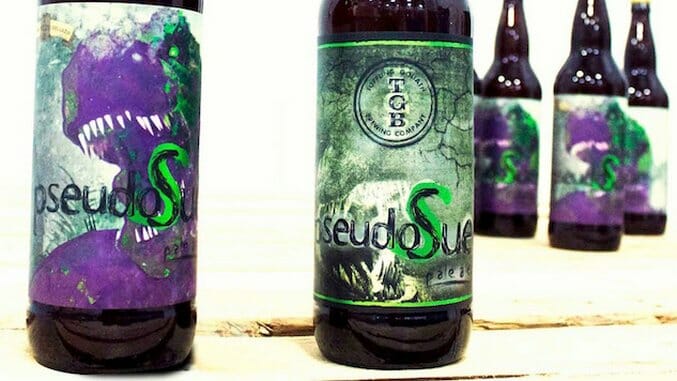Brew News: Turning Brewing Waste Into Battery Power
Photo via Toppling Goliath Drink Features craft beer
This week in the world of beer, Toppling Goliath goes full T. Rex, smart people are working on turning brewery waste water into battery power and Goose Island is looking to take over the United Kingdom.
Chicago: A Jurassic pact
Thanks to a new cultural exchange of sorts, getting your hands on Toppling Goliath Brewing Co.’s much heralded pale ale, pseudoSue, will no longer require a trip to the upper Midwest. Chicago’s The Field Museum happens to have a Sue of its own in the form of a 40-foot long, a 67 million-year-old Tyrannosaurus rex skeleton. When the museum noticed that Iowa’s highest rated brewery was cranking out cans bearing the likeness of a T. Rex and evoking the same name, they decided to seek collaboration as opposed to litigation. pseudoSue will now be served at the museum’s Filed Bistro and the two entities will also work together to produce a new beer inspired by the museum’s collections. Toppling Goliath plans to expand distribution to Illinois in 2018, but for now amateur paleontologists and professional beer geeks can purchase four-packs of Sue in the museum gift shop.
Austin: It’s gotta be the shoes
If the fact that the last two Beer Mile World Champions scored endorsement deals wasn’t enough to convince you that the activity is becoming more legit, consider the recent news that a former world record holder has just unveiled the first official beer mile shoe. Lewis Kent—the 2014 beer mile champion—is the face behind the “Beer Mile” Hyperion by Brooks Running. The shoe is “formulated for premium wet-dry traction and skid resistance” which helps during the transition from sprinting to beer chugging. The shoe features a maple leaf on the heel—Kent is Canadian—and the message “Run Hoppy” on the left and “Live Lager” on the right. Kent set the record in 2014, which was topped the next year by Corey Bellemore with a time of 4:34. The 2016 FloTrack Beer Mile World Championships take place December 17 in Austin, Texas.
Boulder, Colorado: Beer-powered
While water may be the least heralded of the Reinheitsgebot mandated beer ingredients, it is certainly the most prevalent. “Breweries use about seven barrels of water for every barrel of beer produced,” according to Tyler Huggins, a graduate student at University of Colorado Boulder, where engineers are working on a method to turn this abundance of wastewater into battery power. Turns out that brewery wastewater is an ideal environment to “create the carbon-based materials needed to make energy storage cells.” The discovery could lead to be a symbiotic relationship—breweries no longer have to spend as much on wastewater treatment and science gets a new source for producing renewable fuel cell technologies. “We see large potential for scaling because there’s nothing required in this process that isn’t already available,” said Huggins.
Nation: U.S. top of hops
The November/December issue of The New Brewer contained the 2016 world harvest reports, which included the news that the United States is now the globe’s top hop producer. It was estimated that 53,200 acres across the country are devoted to hop cultivation, a 79% increase from 2012. Cascade was the most widely grown hop variety, accounting for 15.7% of the total yield. Centennial was second at 10.4% with Simcoe, CTZ and Citra close behind. Mosaic, Chinook, Nugget, Summit and Willamette were the other notable inclusions. Those top 10 hop varieties made up a little more than 70% of the total U.S. hop production. With demand for hop-forward beers at an all time high, aroma/multi-purpose hops now account for 70% of total hop production, whereas only four years ago cultivation was split 50/50 with alpha varieties. Not surprisingly, hops are most prevalent in the Pacific Northwest, which alone contains 50,000 acres of hops, up by around 20,000 acres since 2007. Hop farming has expanded from its traditional territory, however, and Michigan now stands as the fourth largest hop grower while production continues to increase in the central, south, mid-Atlantic and northeastern parts of the country.
London: Duck, duck, Goose Island
The 312 area code—along with its namesake Urban Wheat Ale and Pale Ale—is expanding across the pond. Though Goose Island beers have been available in the United Kingdom since at least 2014, the A-B InBev owned brand will now have its own line of pubs. Dubbed Goose Island Vintage Ale House, the name conjures up images of wood-paneled walls, worn wooden stools and cask-pulled pints. The first Ale House will open in Balham (south London) later this month and serve American smokehouse inspired cuisine. A second location in London is planned for 2017 along with a Belgian outpost. In other ABI news, the beer giant agreed to sell several eastern European brands to Asahi Group Holdings to help assuage concerns related to its $104 billion takeover of SABMiller. Asahi will fork over around $7.8 billion for the rights to Pilsner Urquell (Czech Republic), Tyskie and Lech (Poland), Dreher (Hungary) and Ursus (Romania).